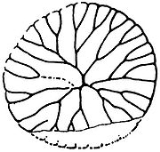
Rugoconites
Encyclopedia
A member of the Ediacaran biota which takes the form of a circular to oval impression preserved in hyporelief, six or more centimeters in diameter. They are surrounded by a frill that has been interpreted (Wade
1972) as a set of tentacle
s. The bifurcating radial ribs, spreading from a central dome, serve to distinguish this genus
from the very similar Paleophragmodictya, and may represent the channels of the gastrovascular
system (Fedonkin
& Cope 1985). Speculation that they may represent sponges (Gehling 1996) is not accepted by Sepkoski
et al. (2002), who interpret it as a jellyfish-like cnidaria
n; it is believed that, in common with Ovatoscutum
, they were free-swimming (Waggonner 1995). Cnidarian affinities are not necessarily refuted by Ivantstov & Fedonkin (2002), who suggest that Rugoconites may possess tri-radial symmetry and be a member of the Trilobozoa
.
Fossil
Rugoconites have been reported in clusters; this may represent a social/colonial way of life, or simply accumulation by the action of currents, sea-floor processes, or possibly preservational conditions (Droser 2007).
Mary Wade (Paleontologist)
Dr Mary Julia Wade was an Australian paleontologist, perhaps best known for her work on the late Precambrian Ediacaran biota in South Australia....
1972) as a set of tentacle
Tentacle
A tentacle or bothrium is one of usually two or more elongated flexible organs present in animals, especially invertebrates. The term may also refer to the hairs of the leaves of some insectivorous plants. Usually, tentacles are used for feeding, feeling and grasping. Anatomically, they work like...
s. The bifurcating radial ribs, spreading from a central dome, serve to distinguish this genus
Genus
In biology, a genus is a low-level taxonomic rank used in the biological classification of living and fossil organisms, which is an example of definition by genus and differentia...
from the very similar Paleophragmodictya, and may represent the channels of the gastrovascular
Gastrovascular cavity
Gastro vascular cavity, as the name indicates, functions in both digestion and the distribution of nutrients and particles to all parts of the body...
system (Fedonkin
Mikhail A. Fedonkin
Dr. Mikhail Aleksandrovich Fedonkin is an awarding winning paleontologist specializing in documentation of the earliest animals' body fossils, tracks, and trails. He was the first to describe several fossils including Hiemalora, Onega stepanovi, and Nimbia occlusa.Fedonkin is fluent in English and...
& Cope 1985). Speculation that they may represent sponges (Gehling 1996) is not accepted by Sepkoski
Jack Sepkoski
J. John Sepkoski Jr., , was a University of Chicago paleontologist. Sepkoski studied the fossil record and the diversity of life on Earth. Sepkoski and David Raup contributed to the knowledge of extinction events...
et al. (2002), who interpret it as a jellyfish-like cnidaria
Cnidaria
Cnidaria is a phylum containing over 9,000 species of animals found exclusively in aquatic and mostly marine environments. Their distinguishing feature is cnidocytes, specialized cells that they use mainly for capturing prey. Their bodies consist of mesoglea, a non-living jelly-like substance,...
n; it is believed that, in common with Ovatoscutum
Ovatoscutum
Ovatoscutum is one of many enigmatic organism known from Ediacaran deposites of the Flinders Ranges, Australia and the White Sea area, Russia. This genera contains one species, Ovatoscutum concentricium....
, they were free-swimming (Waggonner 1995). Cnidarian affinities are not necessarily refuted by Ivantstov & Fedonkin (2002), who suggest that Rugoconites may possess tri-radial symmetry and be a member of the Trilobozoa
Trilobozoa
Trilobozoa is an extinct taxon of organisms which displayed tri-radial symmetry. Trilobozoans were most dominant during the Ediacaran period — prior to the Cambrian explosion of modern life forms....
.
Fossil
Fossil
Fossils are the preserved remains or traces of animals , plants, and other organisms from the remote past...
Rugoconites have been reported in clusters; this may represent a social/colonial way of life, or simply accumulation by the action of currents, sea-floor processes, or possibly preservational conditions (Droser 2007).
External links
- http://www.yuzonakano-secretmemory.com/life3.c.html contains a low-quality image.

